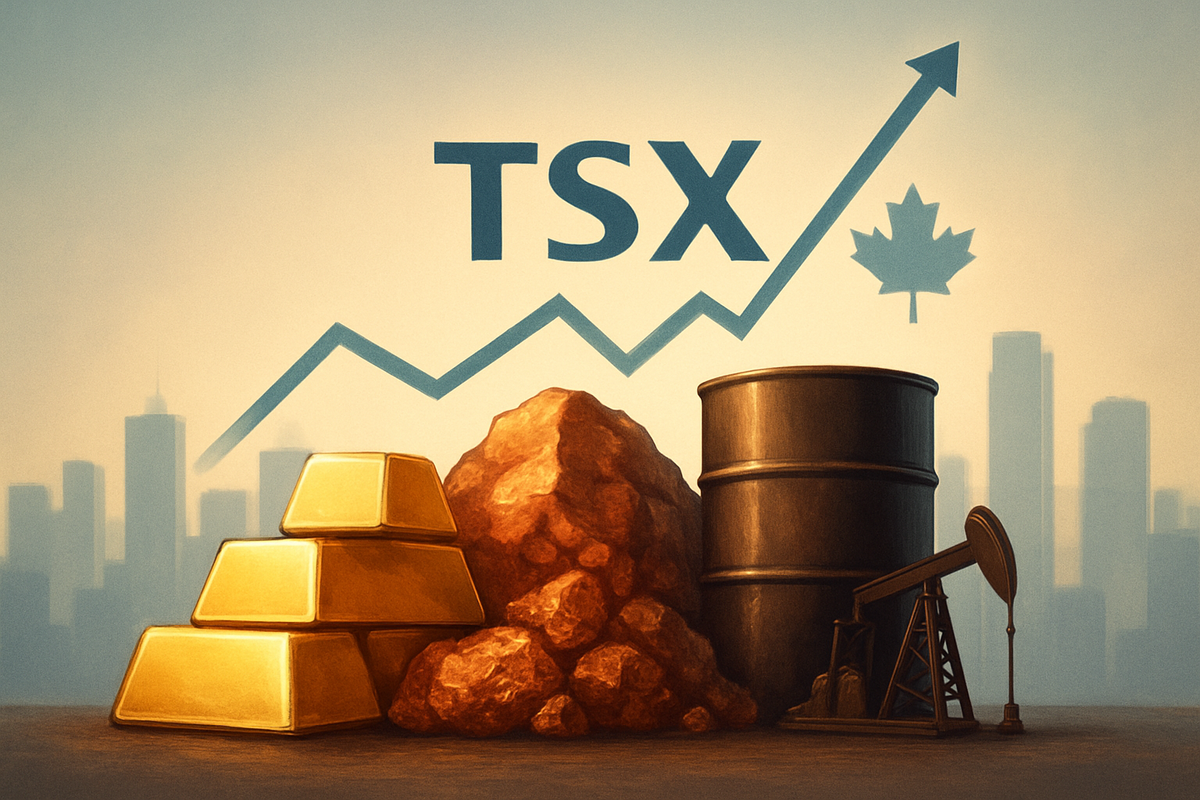
Toronto, Canada – November 6, 2025 – The Toronto Stock Exchange (TSX) composite index, a bellwether for the Canadian economy, recently experienced its most robust rally in three weeks, providing a much-needed lift for investors. However, this upward momentum has since paused, leaving the market in a state of cautious equilibrium. Despite broader market concerns stemming from global economic uncertainties and warnings of stretched valuations, the resilience of the TSX is largely attributed to the sustained strength of commodity prices, which continue to offset prevailing anxieties.
Canada's main stock index, heavily weighted with resource-based companies, finds itself in a unique position where the stellar performance of its materials and energy sectors acts as a significant counterbalance to the more general market jitters. This dynamic highlights the distinct nature of the Canadian market, often marching to the beat of its own drum when global economic currents shift. As the market enters a period of consolidation, the underpinning support from commodities remains a critical factor in maintaining investor sentiment and preventing a deeper correction.
A Rally's Ascent and a Market's Pause
The recent surge in the S&P/TSX composite index was a notable event, with the index climbing an impressive 1.1%, or 325.66 points, to close at 30,103.48 on Wednesday, November 5, 2025. This marked its most substantial single-day gain since October 14, providing a significant rebound after a period of losses that had pushed the index to a one-month low earlier in the week. The rally was fueled by encouraging economic data from the United States, including an eight-month high in services sector activity for October and private payrolls exceeding expectations, which collectively instilled a renewed sense of optimism.
However, the momentum proved fleeting as the TSX composite index entered a period of pause on Thursday, November 6, 2025, remaining largely unchanged. Futures linked to Canada's main stock index reflected this halt, showing only slight increases or remaining flat. This pause is attributed to a confluence of factors, including a general market caution, mixed corporate earnings reports from various sectors, and a lack of clear directional catalysts. Analysts observed that while the commodity strength was undeniable, other market segments were grappling with uncertainty.
Central to the TSX's recent performance has been the robust showing of commodity prices. The materials sector, encompassing metal mining shares, saw a significant gain of 2.7% during the rally, primarily driven by a strong recovery in gold and copper prices. Gold, in particular, has been a standout, soaring above US$4,000 per ounce, a price point it first surpassed in October. This surge is largely due to its traditional role as a safe-haven asset amidst ongoing economic and geopolitical uncertainties, including concerns over a prolonged U.S. government shutdown. The energy sector also played a vital supporting role, with oil prices edging higher, contributing to a 1.0% increase in the week preceding November 5, 2025, and an impressive 13% gain over the past 12 months. Copper prices also rebounded, breaking a four-day decline and easing selling pressure. These strong commodity performances have demonstrably helped to counteract broader market caution and weaker earnings from non-resource sectors, showcasing investor confidence in the commodities narrative.
Corporate Fortunes: Winners and Losers in a Two-Speed Market
The current market environment on the TSX has created a distinct two-speed dynamic, where resource-focused companies are thriving on the back of elevated commodity prices, while several non-resource sectors face considerable headwinds from broader market caution and economic uncertainties. This divergence is shaping the fortunes of public companies across Canada.
On the winning side, the energy sector continues to be a primary beneficiary. Major players like Suncor Energy Inc. (TSX: SU), Canadian Natural Resources (TSX: CNQ), Imperial Oil (TSX: IMO), and Cenovus Energy (TSX: CVE) are reporting robust earnings and strong operational performance, driven by rising crude oil prices. Canadian Natural Resources, for instance, reported record production in Q3 2025, underscoring the sector's resilience. Similarly, the materials sector, particularly gold and other metal miners, is experiencing bolstered investor sentiment. Companies such as Agnico Eagle (TSX: AEM), Wheaton Precious Metals (TSX: WPM), Barrick Gold (TSX: ABX), and Kinross Gold Corporation (TSX: K) are seeing significant gains as gold maintains its appeal as a safe-haven asset, trading above US$4,000 per ounce. Royalty companies like OR Royalties (TSX: OR) also benefit from this trend, offering stable revenue streams without direct operational risks. These firms are enjoying a period of strong profitability and investor confidence, largely insulated from the broader market's anxieties.
Conversely, several non-resource sectors and their constituent companies are navigating a more challenging landscape. The Consumer Discretionary sector is particularly vulnerable, with companies like high-end fashion retailer Aritzia (TSX: ATZ) and luxury apparel brand Canada Goose (TSX: GOOS) facing decreased demand as consumers tighten their belts amidst inflation and economic uncertainty. While some strong brands may see recovery potential, their current sensitivity to macroeconomic shifts and elevated interest rates remains a concern. The Financials sector, especially Canadian banks, including Royal Bank of Canada (TSX: RY), Toronto-Dominion Bank (TSX: TD), Bank of Nova Scotia (TSX: BNS), Bank of Montreal (TSX: BMO), Canadian Imperial Bank of Commerce (TSX: CM), and National Bank of Canada (TSX: NA), are under scrutiny due to broader economic weakness, high consumer debt, and potential pressure on Net Interest Margins (NIMs) from Bank of Canada interest rate cuts. Despite some banks exceeding earnings expectations recently, underlying economic fragility and concerns over a potential mortgage crisis loom.
The Real Estate sector also remains a significant area of concern, grappling with persistent affordability challenges, high household debt, and softening labor markets. Higher financing costs are impacting development, with reports of distress in some Toronto condo projects. CT Real Estate Investment Trust (TSX: CRT.UN), for example, shows forecast annual revenue growth trailing the broader Canadian market average, indicating potential underlying weaknesses. In the Technology & Communication Services sectors, companies like e-commerce giant Shopify (TSX: SHOP) have experienced margin pressure from increased research and development expenses, contributing to stock declines. While the Canadian tech industry saw a surge earlier in 2025, it faces vulnerabilities from increased investor caution and sophisticated cyber threats. Even in the Industrials sector, some companies like Canadian National Railway (TSX: CNR) and Air Canada (TSX: AC) are reporting lower net profit margins and contracting earnings, highlighting the pervasive impact of broader economic slowdowns on their operations.
Wider Significance: Canada's Resource Resilience in a Shifting Global Landscape
The sustained support from commodity prices for the TSX, even amidst broader market pauses, carries profound wider significance for Canada's economy, its place in global trade, and the trajectory of its public companies. This phenomenon underscores Canada's enduring identity as a resource-rich nation, strategically positioned to leverage global demand for both traditional safe-haven assets and the critical minerals essential for the ongoing energy transition.
This event fits into several broader industry trends. The surge in gold prices, exceeding US$4,000 per ounce, reflects persistent global economic uncertainty, geopolitical tensions, and concerns over events like a prolonged U.S. government shutdown, solidifying gold's role as a crucial safe-haven asset. Simultaneously, Canada is at the forefront of a burgeoning critical minerals boom, driven by the rapid growth of the electric vehicle (EV) sector and the broader green and digital economies. With approximately 10% of the world's proven mineral reserves and high mineral diversity, Canada is seizing a "generational opportunity" in minerals like lithium, copper, graphite, and rare earths. While global commodity prices are generally projected to decline modestly in 2025-2026, oil prices have remained relatively strong due to geopolitical factors and OPEC+ discipline. This confluence of factors has propelled the TSX to outperform the S&P 500, surging over 20% year-to-date by November 2025, overwhelmingly attributed to its resource-focused shares, which are seen as a hedge against inflation and geopolitical risks.
The ripple effects of this commodity-driven strength are extensive. Domestically, robust commodity performance can lead to a stronger Canadian dollar, which, while making imports cheaper, can also make exports from Canada's non-resource sectors more expensive, potentially eroding their global competitiveness. Conversely, it directly boosts the profitability and investment capacity of Canadian mining, oil, and gas producers. Internationally, Canada is actively diversifying its trade relationships beyond its traditional reliance on the U.S., seeking new reliable markets, particularly in the Asia-Pacific region for agricultural exports and promoting nuclear energy and clean technology. Strategic international partnerships for critical minerals, such as those with South Korea and Japan, are also forming. However, a crucial risk remains: any sudden global economic slowdown or increase in commodity supply could rapidly reverse the fortunes of currently thriving resource companies.
Beyond U.S. tariffs, which have seen some Canadian retaliatory measures removed for CUSMA-qualifying goods as of September 1, 2025 (excluding steel, aluminum, and motor vehicles), several regulatory and policy implications are at play. Canada's "new industrial strategy" aims to reduce over-reliance on a single trading partner and diversify trade, backed by a $5 billion Strategic Response Fund and a $5 billion Trade Diversification Corridors Fund. Crucially, Budget 2025 introduces a $2 billion Critical Minerals Sovereign Fund and expanded tax credits, designating these minerals as national security priorities under the Defence Production Act, providing guaranteed buyers and hinting at government-backed price floors. In energy policy, the government has scrapped the oil and gas emissions cap, pivoting to an enhanced industrial carbon pricing system and offering tax write-offs for "low-carbon liquefied natural gas facilities" to prioritize economic competitiveness. The federal government has also increased support for agricultural programs and implemented Canadian Sustainability Disclosure Standards (CSDS 1 and CSDS 2) to boost investor confidence in sustainable investments, though potential regulatory rollbacks in the U.S. could impact the broader ESG landscape.
Historically, the TSX has demonstrated resilience due to commodity strength during periods of broader market weakness. This current scenario draws parallels to past commodity supercycles, such as the early 2000s, where the TSX significantly outperformed global indices due to rising demand from emerging economies. This suggests investors are again turning to hard assets as a hedge. However, the current context presents unique elements: a heightened focus on energy transition commodities (critical minerals) rather than solely oil and gas, a deliberate policy of geopolitical and trade diversification by the Canadian government, and a more pronounced level of direct government intervention and strategic investment in critical mineral sectors. These distinctions suggest that while history offers guidance, the current market dynamic is shaped by unique modern imperatives.
What Comes Next: Navigating a Volatile Yet Opportunity-Rich Landscape
Looking ahead, the TSX and its underlying commodity markets are poised for a period of continued dynamism, marked by both opportunities and challenges in the short to medium term (next 3-12 months). Analysts generally anticipate moderate growth for the TSX, but with increased volatility and significant sectoral shifts, while key commodities are expected to follow distinct trajectories.
For the TSX, analysts forecast continued, albeit slower, growth through late 2025 and into 2026, with earnings growth for the S&P/TSX Composite expected in the range of 8-10% in 2025. A base case scenario suggests ongoing economic growth, rising corporate profits, and gradual interest rate reductions from the Bank of Canada will support the market. However, lingering political uncertainties in Canada and global trade tensions, such as U.S. tariffs, could introduce market swings. Strategic pivots for investors include overweighting resilient sectors like materials (driven by gold) and financials, while undervalued energy and other materials firms might offer attractive entry points for long-term investors. Canadian stocks also present a dividend yield advantage, appealing to income-focused investors as interest rates decline. The key challenge remains the potential for the TSX to underperform U.S. indexes due to its heavy concentration in materials and energy, with inflation and the Bank of Canada's interest rate policy being critical determinants of market direction.
In the commodity markets, the outlook varies significantly by type. Gold is expected to maintain its bullish momentum, with forecasts from institutions like Goldman Sachs and Morgan Stanley projecting prices to reach $4,000 to $4,400 per ounce by mid-2026, and some "bull case" scenarios even eyeing $5,000 per ounce. Persistent geopolitical tensions, central bank buying, and anticipated easing from the U.S. Federal Reserve are strong tailwinds. Copper also boasts a bullish outlook, with a structural deficit expected to intensify due to persistent supply disruptions and robust demand from the energy transition, potentially pushing prices to new records of $10,500-$12,000 per metric ton by 2026. Investment in both gold and copper, therefore, appears favorable. Conversely, the outlook for oil (Brent crude) is generally bearish, with J.P. Morgan and the U.S. Energy Information Administration (EIA) forecasting declines to $66/bbl in 2025 and even lower in 2026, driven by an expected oversupply as global supply growth outpaces demand recovery. Investors might consider hedging strategies or reallocating from energy to other sectors showing stronger fundamentals, though short-term geopolitical risks could still trigger temporary price spikes.
For critical minerals like lithium, nickel, cobalt, and rare earths, the long-term demand remains exceptionally strong due to the accelerating global energy transition. However, short-term dynamics can be volatile. Lithium and nickel might experience price moderation in the near term due to increased supply, but the overwhelming long-term demand is expected to lead to price recovery and sustained growth. Strategic opportunities include increased M&A activity, creative financing for developers, and the emergence of recycling technologies. Challenges include the geographical concentration of production, significant capital investment requirements for new mines, and ongoing geopolitical risks. Overall, the coming months will require investors to remain agile, closely monitoring global economic indicators, central bank policies, and the evolving supply-demand dynamics within specific commodity markets.
Comprehensive Wrap-Up: Canada's Resource Resilience Endures
The recent performance of the Toronto Stock Exchange underscores a fundamental truth about the Canadian market: its deep and enduring connection to the global commodity cycle. The TSX's pause after a strong rally, while reflecting broader market caution and some sectoral headwinds, has been notably mitigated by the robust and sustained strength of commodity prices. This resilience, particularly from the energy and materials sectors, has acted as a powerful buffer, preventing a more significant market downturn and highlighting Canada's unique economic structure.
Moving forward, the market appears to be operating on a two-speed trajectory. Resource-focused companies are poised for continued strength, driven by persistent demand for safe-haven assets like gold amidst global uncertainty, and the insatiable need for critical minerals to fuel the energy transition. This provides a compelling narrative for investors seeking exposure to hard assets and long-term secular growth trends. Conversely, non-resource sectors, particularly consumer discretionary, parts of financials, and real estate, will likely face ongoing pressures from economic slowdowns, high interest rates, and cautious consumer spending. This divergence necessitates a nuanced investment approach, emphasizing diversification and careful selection within the Canadian market.
The lasting impact of this period will likely solidify Canada's role as a critical global supplier of essential resources. Government policies, including the Critical Minerals Sovereign Fund and strategic trade diversification efforts, are actively shaping this future, aiming to enhance Canada's competitive advantage and reduce reliance on single trading partners. Historically, the TSX has demonstrated its ability to weather broader market storms on the back of commodity strength, and this current episode reinforces that pattern, albeit with new dynamics driven by the green economy.
Investors should closely watch several key indicators in the coming months: the trajectory of global inflation and central bank interest rate decisions, particularly from the Bank of Canada and the U.S. Federal Reserve; geopolitical developments that could impact commodity supply chains and safe-haven demand; the pace of the global energy transition and its direct effect on critical mineral demand; and the earnings reports from both resource and non-resource sectors to gauge the breadth of economic health. While challenges persist, Canada's resource resilience positions the TSX as a compelling market for those seeking opportunities in a world increasingly reliant on its foundational commodities.
This content is intended for informational purposes only and is not financial advice





